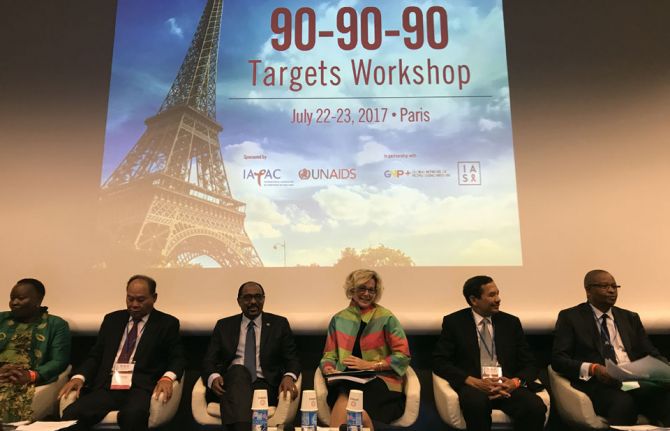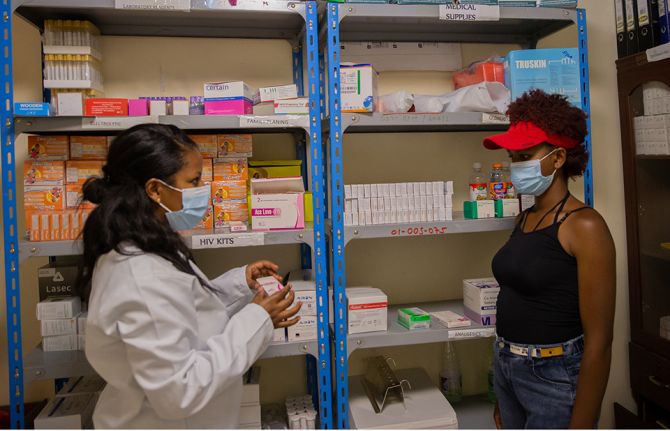

Update
Leading scientists celebrate progress towards 90-90-90 targets
25 July 2017
25 July 2017 25 July 2017Hundreds of the world’s leading HIV researchers, programme planners and implementers and civil society advocates gathered prior to the 2017 IAS Conference on HIV Science to assess progress towards the 90-90-90 targets. The workshop, sponsored by the International Association of Providers of AIDS Care (IAPAC) and UNAIDS, in partnership with the Global Network of People Living with HIV, focused on the latest data on progress and on new opportunities to continue to speed gains towards the 90-90-90 milestones.
The targets were launched by UNAIDS in 2014 to accelerate progress so that, by 2020, 90% of all people living with HIV know their HIV status, 90% of all people with diagnosed HIV are accessing sustained antiretroviral therapy and 90% of all people accessing antiretroviral therapy are virally suppressed. In 2016, for the first time, more than two-thirds of people living with HIV knew their HIV status and more than half of all people living with HIV had access to antiretroviral therapy.
Celebrating the marked advances made towards each of the three 90s, attendees agreed that attainment of 90-90-90 and ultimate control of the epidemic are achievable. New evidence of sharp declines in HIV incidence in numerous countries in eastern and southern Africa demonstrates that HIV treatment scale-up is not only reducing AIDS-related deaths but also contributing to epidemic control.
Following a keynote address by UNAIDS Executive Director Michel Sidibé, the workshop began with a dialogue between health ministers and senior ministerial officials from Botswana, Cambodia, Lesotho and Panama and global health leaders. This political session highlighted examples of how numerous countries are translating strong political commitment on AIDS into achievement of the 90-90-90 target.
Workshop sessions focused on areas where the push for 90-90-90 is falling short, on populations that are being left behind, and on potentially transformative opportunities to close these gaps. With the greatest gap across the HIV treatment cascade occurring at the first 90, participants called for an HIV testing revolution, including initiatives to nest HIV testing with screening programmes for other health conditions. Workshop presentations also underscored the importance of rapid roll-out of HIV self-testing.
To attain 90-90-90, it is clear that services must be expanded beyond health facilities and brought closer to the communities that need them. This conclusion was buttressed by findings from the SEARCH and PopART trials, which employed community-centred approaches to generate rapid progress towards the 90-90-90 targets. To enable the rapid scale-up of community-based services, African Union Heads of State this month enthusiastically endorsed a new regional initiative to recruit, train and deploy 2 million community health workers.
Multiple workshop sessions focused on challenges in reaching populations that are being left behind, including men, adolescent girls and young women, and such key populations as gay men and other men who have sex with men, people who inject drugs, sex workers and transgender people. Data presentations on diverse national and local experiences highlighted various strategies to close testing and treatment gaps among these groups, including service delivery strategies tailored to these groups, investment in communities, and strategies to minimize stigma and discrimination, including law and policy reform.
New resources will be needed to Fast-Track the global AIDS response, as amounts available for HIV programmes are roughly 25% short of the resource target for the Fast-Track response. According to modelling data presented at the workshop, South Africa could save US$3 billion and avert 1 million AIDS-related deaths by front-loading investments to reach 90-90-90, compared to continuation of the current pace of scale-up.
Quotes
“Three words characterize Botswana’s response to HIV – clear, bold and driven. This approach mobilized essential investments and generated tangible results [including achievement of the 90-90-90 targets].”
“Cambodia is on track to achieve the 90-90-90 targets. Cambodia’s response to AIDS began in the early 1990s, when the country faced a generalized, fast-growing epidemic. Today, we are focusing on priority populations and aim to eliminate new HIV infections by 2025.”
“AIDS has taken a results-driven approach. That is why I have long championed bold goals and targets for AIDS. The latest data demonstrate that 90-90-90 is not a dream. In the face of skepticism, we have clearly proven that we can achieve 90-90-90. In moving forward, we must pay attention adolescent girls and young women, bring young men into services, and reach vulnerable communities, as key populations account for 80% of new HIV infections outside sub-Saharan Africa.”
“It is not always easy for communities to make a sharp pivot in their approaches, but we have successfully pivoted towards the 90-90-90 target. The latest results for the HIV treatment cascade – 70-77-82 – are inspiring. To attain epidemic control, we will ultimately need to achieve 95-95-95, which will happen only if we focus on people.”
“The ability of communities to respond and political commitment to face and overcome key challenges have together served as the linchpin of the progress we have made towards 90-90-90. National governments rapidly changed their policy approach to implement a test-and-treat approach, and we have invested in the collection and use of granular data at the site level to drive and inform our efforts.”



